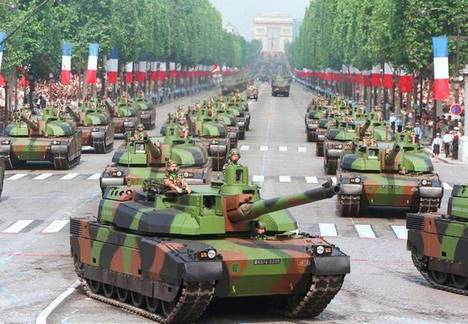
From Ben Barry, RUSI: [W]hilst the other two services can attack enemy land forces, only armies can defeat them. Land power secures ground and gives influence over populations in ways that air or sea power cannot. So armies that can root out enemies and achieve land control remain as valid a military and political tool as naval or air forces. . . .
While US, UK and French land forces are shrinking, all seek to retain a core combined arms combat capability and the robust culture and leadership essential to sustain fighting spirit. They plan to maintain the advances made in combined arms capability over the last decade, such as precision artillery, attack helicopters and air/land integration. And they are institutionalising the progress made in ISTAR, including the use of tactical surveillance drones and dedicated ISTAR formations such as the US Army Battlefield Surveillance Brigades, the French Intel Brigade and the new British ISTAR Brigade.
The US Army will retain three different types of Brigade Combat Teams (BCTs): heavy BCTs with tracked armoured vehicles; Stryker BCTs using Stryker wheeled armoured personnel carriers (APCs); and infantry BCTs, which will all retain their airborne and air assault divisions. And while there will be fewer BCTs, these will be larger, with a third manoeuvre battalion. The USMC amphibious capability, a mixture of light and medium capability, will also remain.
The French and British, meanwhile, have significantly reduced their operational ambitions, including the size of forces to be deployed overseas. The British Army, as a result, is undergoing its most radical re-organisation for fifty years, including a 20 per cent reduction in regular manpower. A ‘Reaction Force’ will have a division of three heavy armoured infantry brigades with a mixture of tanks and armoured infantry. The Air Assault Brigade will retain its mixture of parachute battalions and attack helicopters, although its ground element will shrink, as will the army’s contribution to the Royal Navy’s amphibious force. At the same time, a mixed regular-reserve ‘Adaptable Force’ division of infantry brigades will be able to generate up to two, largely regular, combined arms light brigades for an enduring stabilisation operation. Concurrently, the French government’s Livre Blanc sees the French Army reducing from eight to seven its all arms brigades (two heavy, three medium and two light), meaning that the British and French land components will be of roughly equivalent size, albeit with a different mix of brigade capabilities.
As well as airborne and amphibious ‘early entry’ formations, all three nations will also retain heavy armoured brigades. These will be capable of hard fighting against both conventional and ‘hybrid’ enemies, and of undertaking the toughest of peace-enforcement missions. The US and French forces will also retain substantial medium forces based on wheeled armour. The British will not have similar brigades, although the Adaptable Force will have some infantry in Foxhound light protected vehicles and ‘light cavalry’ in Jackal mine-protected scout vehicles.
All three countries also plan to modernise their aging armoured vehicle fleets. The US Marine Corps seeks new amphibious armoured vehicles and wheeled APCs. The US Army needs to modernise its Abrams tanks and Stryker APCs and replace M113 utility vehicles with an Armoured Multipurpose Vehicle. A new Ground Combat Vehicle (GCV) is to replace the Bradley fighting vehicles. At an estimated cost of $29 billion, the GCV is the largest and most expensive armoured-vehicle programme in NATO.
Future British capability depends on a £5 billion armoured-vehicle modernisation programme. As well as new armoured Scout and utility vehicles, the Warrior infantry fighting vehicle and Challenger tank are to be upgraded. The French are fielding the VBCI wheeled infantry fighting vehicle and developing new wheeled APCs and cavalry vehicles.
Brigadier (Rtd) Ben Barry OBE, Senior Fellow Land Warfare, International Institute for Strategic Studies (IISS). (photo: Le Figaro)
Image: le%20figaro%202007%20Bastille%20Day%20parade.jpg
